Boko Haram Insurgency in Nigeria: Causes, Impact, and Solutions
VerifiedAdded on 2023/04/20
|53
|15408
|492
Report
AI Summary
This report provides a comprehensive analysis of the Boko Haram insurgency in Nigeria, examining its origins, objectives, and impact. The report delves into the group's ideology, its methods of operation, and its expansion across the northeastern region and neighboring countries. It explores the Nigerian government's response, including military strategies and the involvement of neighboring countries like Chad, Cameroon, and Niger. The research identifies key research objectives and questions, assessing the existing approaches to counter the insurgency. Moreover, the report analyzes the forms of warfare from which the Nigerian government can draw inspiration, and proposes recommendations for enhanced coordination with neighboring countries. The report considers the implications of inaction, and concludes with suggestions for future research, offering insights into the complex challenges posed by Boko Haram and potential avenues for conflict resolution.

Running head: BOKO HARAM INSURGENCY IN NIGERIA
Boko Haram Insurgency in Nigeria
Name of the Student
Name of the University
Author Note
Boko Haram Insurgency in Nigeria
Name of the Student
Name of the University
Author Note
Paraphrase This Document
Need a fresh take? Get an instant paraphrase of this document with our AI Paraphraser
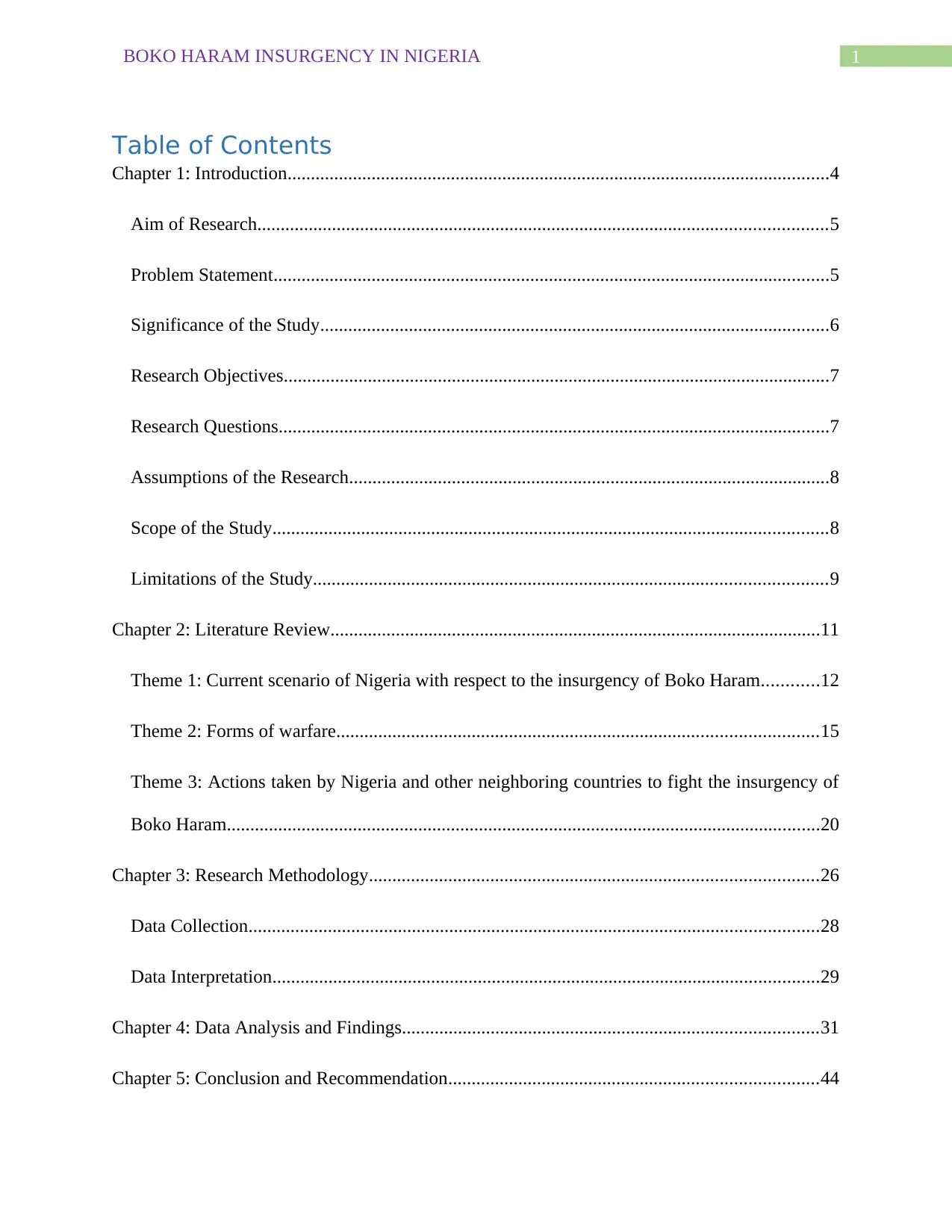
1BOKO HARAM INSURGENCY IN NIGERIA
Table of Contents
Chapter 1: Introduction....................................................................................................................4
Aim of Research..........................................................................................................................5
Problem Statement.......................................................................................................................5
Significance of the Study.............................................................................................................6
Research Objectives.....................................................................................................................7
Research Questions......................................................................................................................7
Assumptions of the Research.......................................................................................................8
Scope of the Study.......................................................................................................................8
Limitations of the Study..............................................................................................................9
Chapter 2: Literature Review.........................................................................................................11
Theme 1: Current scenario of Nigeria with respect to the insurgency of Boko Haram............12
Theme 2: Forms of warfare.......................................................................................................15
Theme 3: Actions taken by Nigeria and other neighboring countries to fight the insurgency of
Boko Haram...............................................................................................................................20
Chapter 3: Research Methodology................................................................................................26
Data Collection..........................................................................................................................28
Data Interpretation.....................................................................................................................29
Chapter 4: Data Analysis and Findings.........................................................................................31
Chapter 5: Conclusion and Recommendation...............................................................................44
Table of Contents
Chapter 1: Introduction....................................................................................................................4
Aim of Research..........................................................................................................................5
Problem Statement.......................................................................................................................5
Significance of the Study.............................................................................................................6
Research Objectives.....................................................................................................................7
Research Questions......................................................................................................................7
Assumptions of the Research.......................................................................................................8
Scope of the Study.......................................................................................................................8
Limitations of the Study..............................................................................................................9
Chapter 2: Literature Review.........................................................................................................11
Theme 1: Current scenario of Nigeria with respect to the insurgency of Boko Haram............12
Theme 2: Forms of warfare.......................................................................................................15
Theme 3: Actions taken by Nigeria and other neighboring countries to fight the insurgency of
Boko Haram...............................................................................................................................20
Chapter 3: Research Methodology................................................................................................26
Data Collection..........................................................................................................................28
Data Interpretation.....................................................................................................................29
Chapter 4: Data Analysis and Findings.........................................................................................31
Chapter 5: Conclusion and Recommendation...............................................................................44
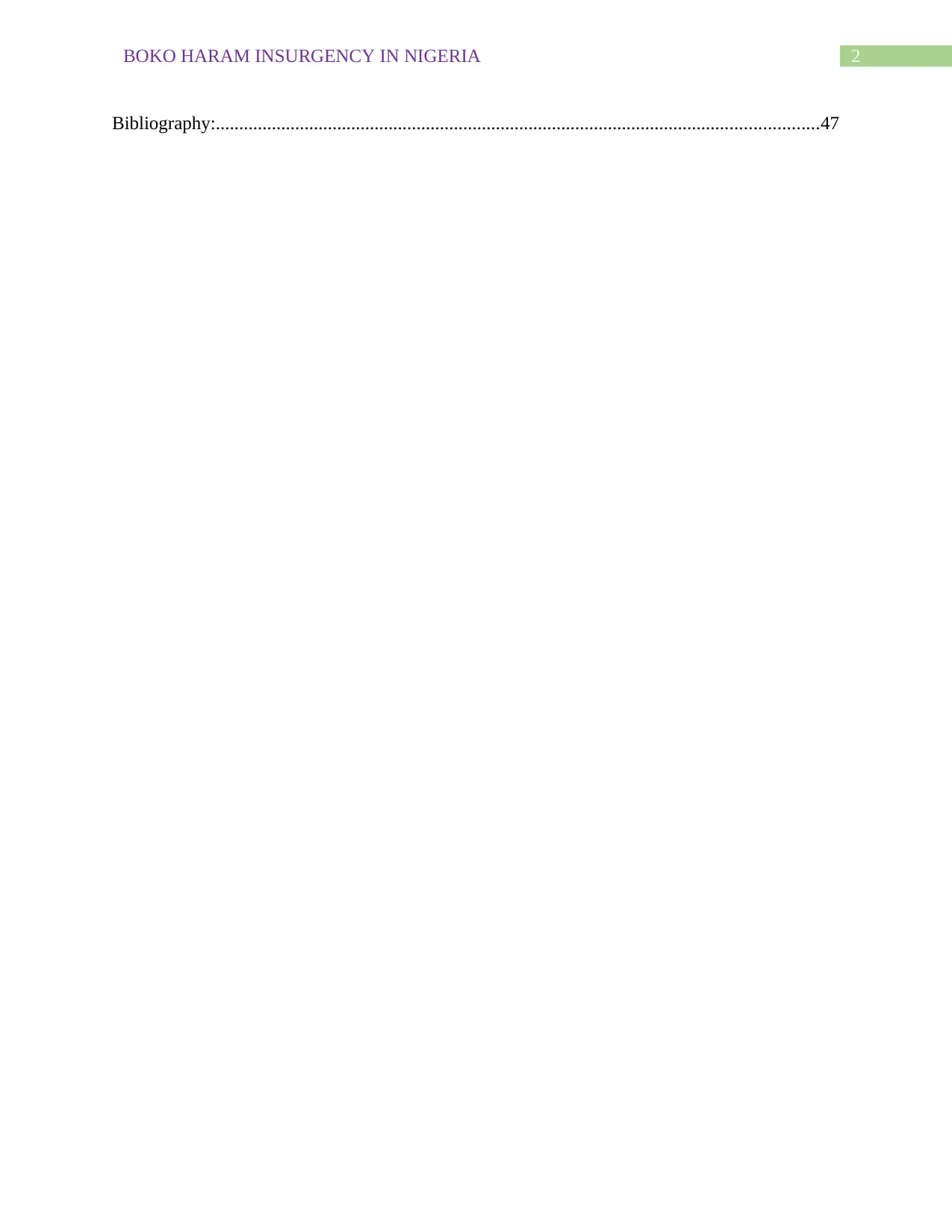
2BOKO HARAM INSURGENCY IN NIGERIA
Bibliography:.................................................................................................................................47
Bibliography:.................................................................................................................................47
⊘ This is a preview!⊘
Do you want full access?
Subscribe today to unlock all pages.

Trusted by 1+ million students worldwide
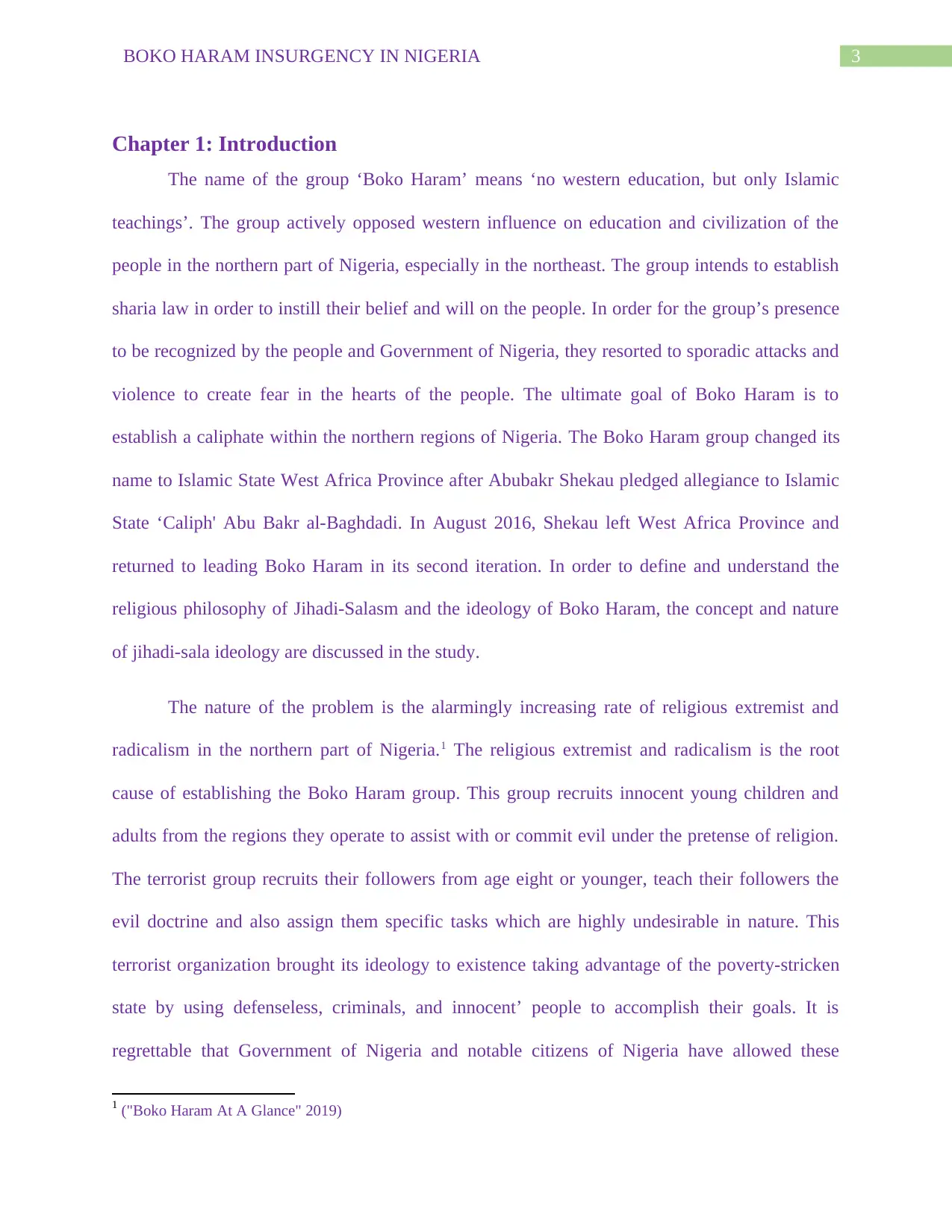
3BOKO HARAM INSURGENCY IN NIGERIA
Chapter 1: Introduction
The name of the group ‘Boko Haram’ means ‘no western education, but only Islamic
teachings’. The group actively opposed western influence on education and civilization of the
people in the northern part of Nigeria, especially in the northeast. The group intends to establish
sharia law in order to instill their belief and will on the people. In order for the group’s presence
to be recognized by the people and Government of Nigeria, they resorted to sporadic attacks and
violence to create fear in the hearts of the people. The ultimate goal of Boko Haram is to
establish a caliphate within the northern regions of Nigeria. The Boko Haram group changed its
name to Islamic State West Africa Province after Abubakr Shekau pledged allegiance to Islamic
State ‘Caliph' Abu Bakr al-Baghdadi. In August 2016, Shekau left West Africa Province and
returned to leading Boko Haram in its second iteration. In order to define and understand the
religious philosophy of Jihadi-Salasm and the ideology of Boko Haram, the concept and nature
of jihadi-sala ideology are discussed in the study.
The nature of the problem is the alarmingly increasing rate of religious extremist and
radicalism in the northern part of Nigeria.1 The religious extremist and radicalism is the root
cause of establishing the Boko Haram group. This group recruits innocent young children and
adults from the regions they operate to assist with or commit evil under the pretense of religion.
The terrorist group recruits their followers from age eight or younger, teach their followers the
evil doctrine and also assign them specific tasks which are highly undesirable in nature. This
terrorist organization brought its ideology to existence taking advantage of the poverty-stricken
state by using defenseless, criminals, and innocent’ people to accomplish their goals. It is
regrettable that Government of Nigeria and notable citizens of Nigeria have allowed these
1 ("Boko Haram At A Glance" 2019)
Chapter 1: Introduction
The name of the group ‘Boko Haram’ means ‘no western education, but only Islamic
teachings’. The group actively opposed western influence on education and civilization of the
people in the northern part of Nigeria, especially in the northeast. The group intends to establish
sharia law in order to instill their belief and will on the people. In order for the group’s presence
to be recognized by the people and Government of Nigeria, they resorted to sporadic attacks and
violence to create fear in the hearts of the people. The ultimate goal of Boko Haram is to
establish a caliphate within the northern regions of Nigeria. The Boko Haram group changed its
name to Islamic State West Africa Province after Abubakr Shekau pledged allegiance to Islamic
State ‘Caliph' Abu Bakr al-Baghdadi. In August 2016, Shekau left West Africa Province and
returned to leading Boko Haram in its second iteration. In order to define and understand the
religious philosophy of Jihadi-Salasm and the ideology of Boko Haram, the concept and nature
of jihadi-sala ideology are discussed in the study.
The nature of the problem is the alarmingly increasing rate of religious extremist and
radicalism in the northern part of Nigeria.1 The religious extremist and radicalism is the root
cause of establishing the Boko Haram group. This group recruits innocent young children and
adults from the regions they operate to assist with or commit evil under the pretense of religion.
The terrorist group recruits their followers from age eight or younger, teach their followers the
evil doctrine and also assign them specific tasks which are highly undesirable in nature. This
terrorist organization brought its ideology to existence taking advantage of the poverty-stricken
state by using defenseless, criminals, and innocent’ people to accomplish their goals. It is
regrettable that Government of Nigeria and notable citizens of Nigeria have allowed these
1 ("Boko Haram At A Glance" 2019)
Paraphrase This Document
Need a fresh take? Get an instant paraphrase of this document with our AI Paraphraser
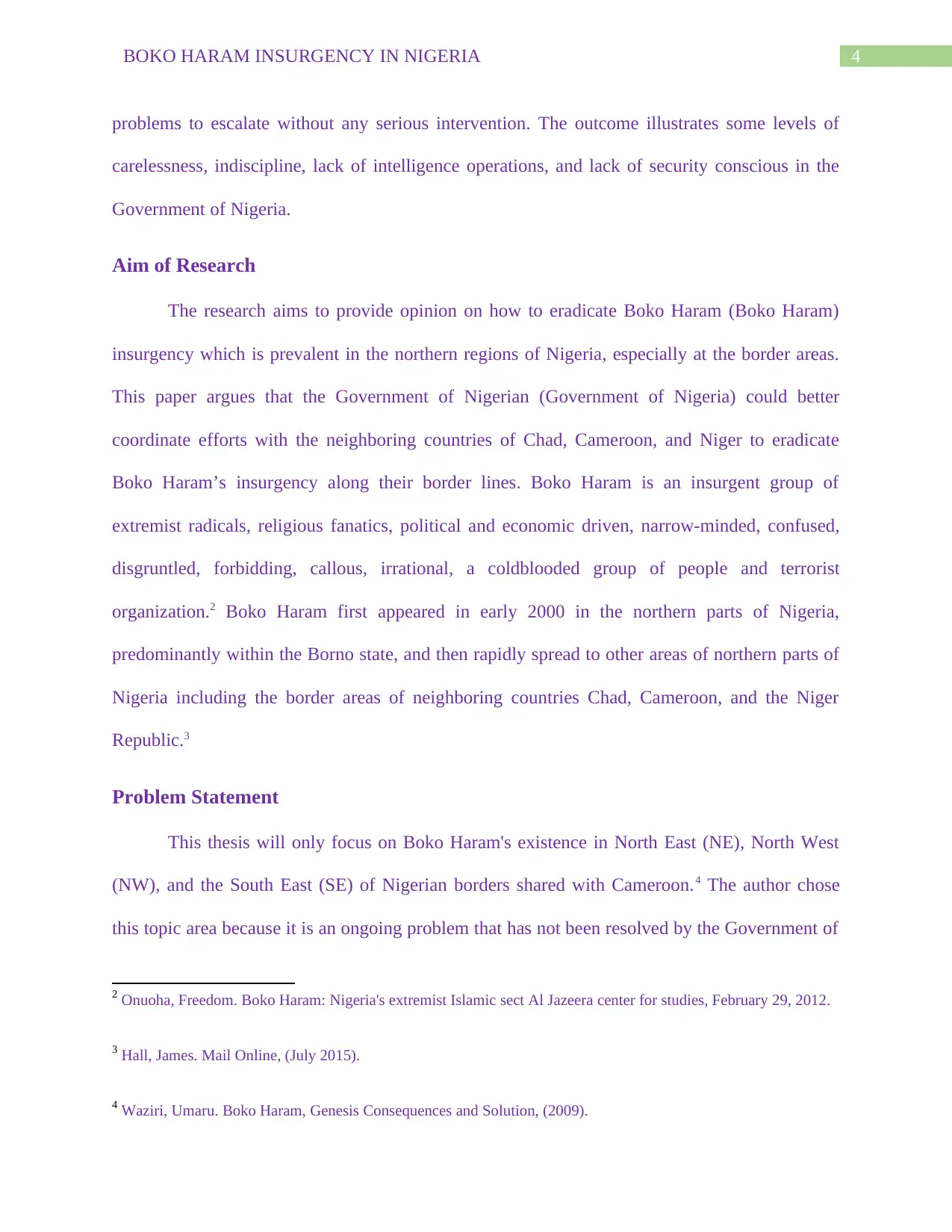
4BOKO HARAM INSURGENCY IN NIGERIA
problems to escalate without any serious intervention. The outcome illustrates some levels of
carelessness, indiscipline, lack of intelligence operations, and lack of security conscious in the
Government of Nigeria.
Aim of Research
The research aims to provide opinion on how to eradicate Boko Haram (Boko Haram)
insurgency which is prevalent in the northern regions of Nigeria, especially at the border areas.
This paper argues that the Government of Nigerian (Government of Nigeria) could better
coordinate efforts with the neighboring countries of Chad, Cameroon, and Niger to eradicate
Boko Haram’s insurgency along their border lines. Boko Haram is an insurgent group of
extremist radicals, religious fanatics, political and economic driven, narrow-minded, confused,
disgruntled, forbidding, callous, irrational, a coldblooded group of people and terrorist
organization.2 Boko Haram first appeared in early 2000 in the northern parts of Nigeria,
predominantly within the Borno state, and then rapidly spread to other areas of northern parts of
Nigeria including the border areas of neighboring countries Chad, Cameroon, and the Niger
Republic.3
Problem Statement
This thesis will only focus on Boko Haram's existence in North East (NE), North West
(NW), and the South East (SE) of Nigerian borders shared with Cameroon.4 The author chose
this topic area because it is an ongoing problem that has not been resolved by the Government of
2 Onuoha, Freedom. Boko Haram: Nigeria's extremist Islamic sect Al Jazeera center for studies, February 29, 2012.
3 Hall, James. Mail Online, (July 2015).
4 Waziri, Umaru. Boko Haram, Genesis Consequences and Solution, (2009).
problems to escalate without any serious intervention. The outcome illustrates some levels of
carelessness, indiscipline, lack of intelligence operations, and lack of security conscious in the
Government of Nigeria.
Aim of Research
The research aims to provide opinion on how to eradicate Boko Haram (Boko Haram)
insurgency which is prevalent in the northern regions of Nigeria, especially at the border areas.
This paper argues that the Government of Nigerian (Government of Nigeria) could better
coordinate efforts with the neighboring countries of Chad, Cameroon, and Niger to eradicate
Boko Haram’s insurgency along their border lines. Boko Haram is an insurgent group of
extremist radicals, religious fanatics, political and economic driven, narrow-minded, confused,
disgruntled, forbidding, callous, irrational, a coldblooded group of people and terrorist
organization.2 Boko Haram first appeared in early 2000 in the northern parts of Nigeria,
predominantly within the Borno state, and then rapidly spread to other areas of northern parts of
Nigeria including the border areas of neighboring countries Chad, Cameroon, and the Niger
Republic.3
Problem Statement
This thesis will only focus on Boko Haram's existence in North East (NE), North West
(NW), and the South East (SE) of Nigerian borders shared with Cameroon.4 The author chose
this topic area because it is an ongoing problem that has not been resolved by the Government of
2 Onuoha, Freedom. Boko Haram: Nigeria's extremist Islamic sect Al Jazeera center for studies, February 29, 2012.
3 Hall, James. Mail Online, (July 2015).
4 Waziri, Umaru. Boko Haram, Genesis Consequences and Solution, (2009).
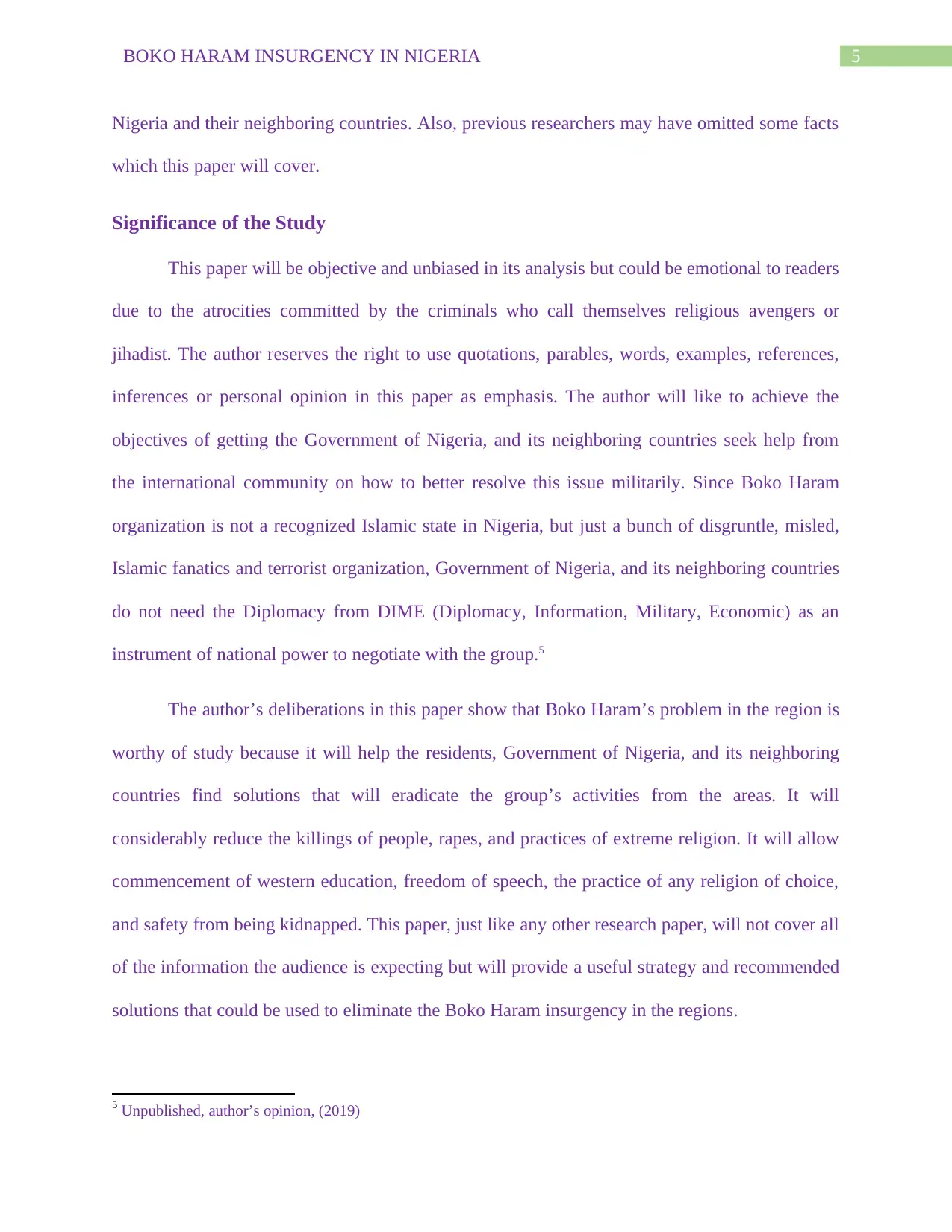
5BOKO HARAM INSURGENCY IN NIGERIA
Nigeria and their neighboring countries. Also, previous researchers may have omitted some facts
which this paper will cover.
Significance of the Study
This paper will be objective and unbiased in its analysis but could be emotional to readers
due to the atrocities committed by the criminals who call themselves religious avengers or
jihadist. The author reserves the right to use quotations, parables, words, examples, references,
inferences or personal opinion in this paper as emphasis. The author will like to achieve the
objectives of getting the Government of Nigeria, and its neighboring countries seek help from
the international community on how to better resolve this issue militarily. Since Boko Haram
organization is not a recognized Islamic state in Nigeria, but just a bunch of disgruntle, misled,
Islamic fanatics and terrorist organization, Government of Nigeria, and its neighboring countries
do not need the Diplomacy from DIME (Diplomacy, Information, Military, Economic) as an
instrument of national power to negotiate with the group.5
The author’s deliberations in this paper show that Boko Haram’s problem in the region is
worthy of study because it will help the residents, Government of Nigeria, and its neighboring
countries find solutions that will eradicate the group’s activities from the areas. It will
considerably reduce the killings of people, rapes, and practices of extreme religion. It will allow
commencement of western education, freedom of speech, the practice of any religion of choice,
and safety from being kidnapped. This paper, just like any other research paper, will not cover all
of the information the audience is expecting but will provide a useful strategy and recommended
solutions that could be used to eliminate the Boko Haram insurgency in the regions.
5 Unpublished, author’s opinion, (2019)
Nigeria and their neighboring countries. Also, previous researchers may have omitted some facts
which this paper will cover.
Significance of the Study
This paper will be objective and unbiased in its analysis but could be emotional to readers
due to the atrocities committed by the criminals who call themselves religious avengers or
jihadist. The author reserves the right to use quotations, parables, words, examples, references,
inferences or personal opinion in this paper as emphasis. The author will like to achieve the
objectives of getting the Government of Nigeria, and its neighboring countries seek help from
the international community on how to better resolve this issue militarily. Since Boko Haram
organization is not a recognized Islamic state in Nigeria, but just a bunch of disgruntle, misled,
Islamic fanatics and terrorist organization, Government of Nigeria, and its neighboring countries
do not need the Diplomacy from DIME (Diplomacy, Information, Military, Economic) as an
instrument of national power to negotiate with the group.5
The author’s deliberations in this paper show that Boko Haram’s problem in the region is
worthy of study because it will help the residents, Government of Nigeria, and its neighboring
countries find solutions that will eradicate the group’s activities from the areas. It will
considerably reduce the killings of people, rapes, and practices of extreme religion. It will allow
commencement of western education, freedom of speech, the practice of any religion of choice,
and safety from being kidnapped. This paper, just like any other research paper, will not cover all
of the information the audience is expecting but will provide a useful strategy and recommended
solutions that could be used to eliminate the Boko Haram insurgency in the regions.
5 Unpublished, author’s opinion, (2019)
⊘ This is a preview!⊘
Do you want full access?
Subscribe today to unlock all pages.

Trusted by 1+ million students worldwide
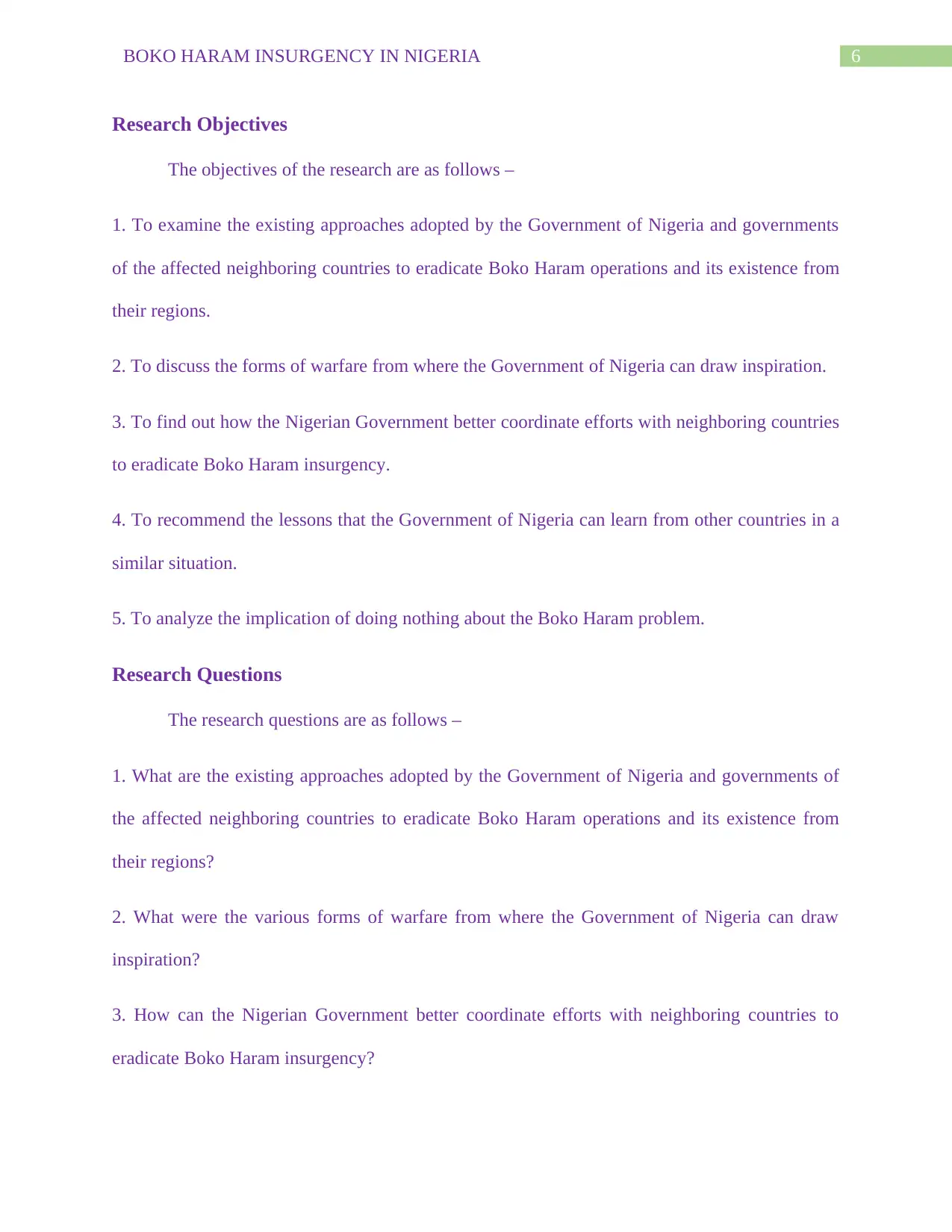
6BOKO HARAM INSURGENCY IN NIGERIA
Research Objectives
The objectives of the research are as follows –
1. To examine the existing approaches adopted by the Government of Nigeria and governments
of the affected neighboring countries to eradicate Boko Haram operations and its existence from
their regions.
2. To discuss the forms of warfare from where the Government of Nigeria can draw inspiration.
3. To find out how the Nigerian Government better coordinate efforts with neighboring countries
to eradicate Boko Haram insurgency.
4. To recommend the lessons that the Government of Nigeria can learn from other countries in a
similar situation.
5. To analyze the implication of doing nothing about the Boko Haram problem.
Research Questions
The research questions are as follows –
1. What are the existing approaches adopted by the Government of Nigeria and governments of
the affected neighboring countries to eradicate Boko Haram operations and its existence from
their regions?
2. What were the various forms of warfare from where the Government of Nigeria can draw
inspiration?
3. How can the Nigerian Government better coordinate efforts with neighboring countries to
eradicate Boko Haram insurgency?
Research Objectives
The objectives of the research are as follows –
1. To examine the existing approaches adopted by the Government of Nigeria and governments
of the affected neighboring countries to eradicate Boko Haram operations and its existence from
their regions.
2. To discuss the forms of warfare from where the Government of Nigeria can draw inspiration.
3. To find out how the Nigerian Government better coordinate efforts with neighboring countries
to eradicate Boko Haram insurgency.
4. To recommend the lessons that the Government of Nigeria can learn from other countries in a
similar situation.
5. To analyze the implication of doing nothing about the Boko Haram problem.
Research Questions
The research questions are as follows –
1. What are the existing approaches adopted by the Government of Nigeria and governments of
the affected neighboring countries to eradicate Boko Haram operations and its existence from
their regions?
2. What were the various forms of warfare from where the Government of Nigeria can draw
inspiration?
3. How can the Nigerian Government better coordinate efforts with neighboring countries to
eradicate Boko Haram insurgency?
Paraphrase This Document
Need a fresh take? Get an instant paraphrase of this document with our AI Paraphraser
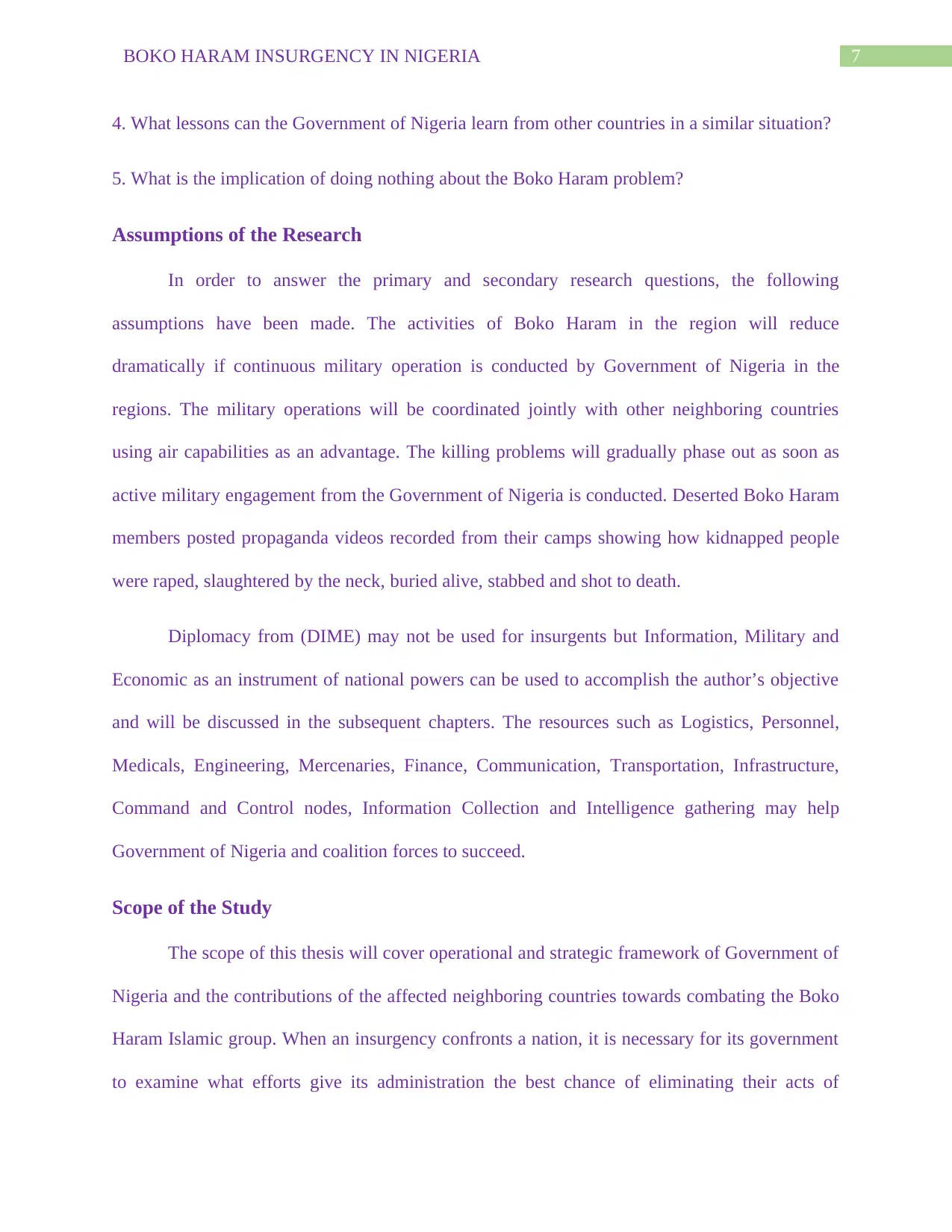
7BOKO HARAM INSURGENCY IN NIGERIA
4. What lessons can the Government of Nigeria learn from other countries in a similar situation?
5. What is the implication of doing nothing about the Boko Haram problem?
Assumptions of the Research
In order to answer the primary and secondary research questions, the following
assumptions have been made. The activities of Boko Haram in the region will reduce
dramatically if continuous military operation is conducted by Government of Nigeria in the
regions. The military operations will be coordinated jointly with other neighboring countries
using air capabilities as an advantage. The killing problems will gradually phase out as soon as
active military engagement from the Government of Nigeria is conducted. Deserted Boko Haram
members posted propaganda videos recorded from their camps showing how kidnapped people
were raped, slaughtered by the neck, buried alive, stabbed and shot to death.
Diplomacy from (DIME) may not be used for insurgents but Information, Military and
Economic as an instrument of national powers can be used to accomplish the author’s objective
and will be discussed in the subsequent chapters. The resources such as Logistics, Personnel,
Medicals, Engineering, Mercenaries, Finance, Communication, Transportation, Infrastructure,
Command and Control nodes, Information Collection and Intelligence gathering may help
Government of Nigeria and coalition forces to succeed.
Scope of the Study
The scope of this thesis will cover operational and strategic framework of Government of
Nigeria and the contributions of the affected neighboring countries towards combating the Boko
Haram Islamic group. When an insurgency confronts a nation, it is necessary for its government
to examine what efforts give its administration the best chance of eliminating their acts of
4. What lessons can the Government of Nigeria learn from other countries in a similar situation?
5. What is the implication of doing nothing about the Boko Haram problem?
Assumptions of the Research
In order to answer the primary and secondary research questions, the following
assumptions have been made. The activities of Boko Haram in the region will reduce
dramatically if continuous military operation is conducted by Government of Nigeria in the
regions. The military operations will be coordinated jointly with other neighboring countries
using air capabilities as an advantage. The killing problems will gradually phase out as soon as
active military engagement from the Government of Nigeria is conducted. Deserted Boko Haram
members posted propaganda videos recorded from their camps showing how kidnapped people
were raped, slaughtered by the neck, buried alive, stabbed and shot to death.
Diplomacy from (DIME) may not be used for insurgents but Information, Military and
Economic as an instrument of national powers can be used to accomplish the author’s objective
and will be discussed in the subsequent chapters. The resources such as Logistics, Personnel,
Medicals, Engineering, Mercenaries, Finance, Communication, Transportation, Infrastructure,
Command and Control nodes, Information Collection and Intelligence gathering may help
Government of Nigeria and coalition forces to succeed.
Scope of the Study
The scope of this thesis will cover operational and strategic framework of Government of
Nigeria and the contributions of the affected neighboring countries towards combating the Boko
Haram Islamic group. When an insurgency confronts a nation, it is necessary for its government
to examine what efforts give its administration the best chance of eliminating their acts of
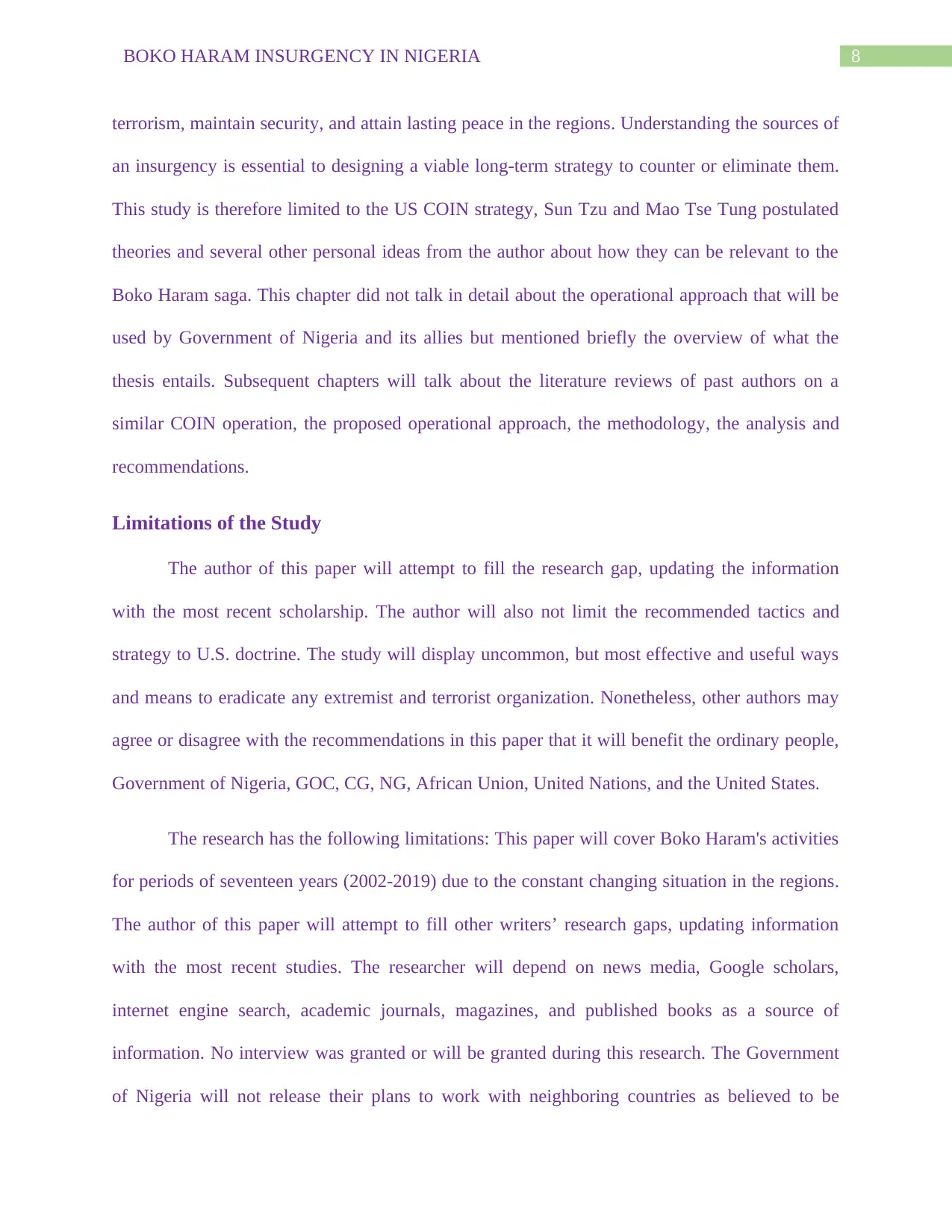
8BOKO HARAM INSURGENCY IN NIGERIA
terrorism, maintain security, and attain lasting peace in the regions. Understanding the sources of
an insurgency is essential to designing a viable long-term strategy to counter or eliminate them.
This study is therefore limited to the US COIN strategy, Sun Tzu and Mao Tse Tung postulated
theories and several other personal ideas from the author about how they can be relevant to the
Boko Haram saga. This chapter did not talk in detail about the operational approach that will be
used by Government of Nigeria and its allies but mentioned briefly the overview of what the
thesis entails. Subsequent chapters will talk about the literature reviews of past authors on a
similar COIN operation, the proposed operational approach, the methodology, the analysis and
recommendations.
Limitations of the Study
The author of this paper will attempt to fill the research gap, updating the information
with the most recent scholarship. The author will also not limit the recommended tactics and
strategy to U.S. doctrine. The study will display uncommon, but most effective and useful ways
and means to eradicate any extremist and terrorist organization. Nonetheless, other authors may
agree or disagree with the recommendations in this paper that it will benefit the ordinary people,
Government of Nigeria, GOC, CG, NG, African Union, United Nations, and the United States.
The research has the following limitations: This paper will cover Boko Haram's activities
for periods of seventeen years (2002-2019) due to the constant changing situation in the regions.
The author of this paper will attempt to fill other writers’ research gaps, updating information
with the most recent studies. The researcher will depend on news media, Google scholars,
internet engine search, academic journals, magazines, and published books as a source of
information. No interview was granted or will be granted during this research. The Government
of Nigeria will not release their plans to work with neighboring countries as believed to be
terrorism, maintain security, and attain lasting peace in the regions. Understanding the sources of
an insurgency is essential to designing a viable long-term strategy to counter or eliminate them.
This study is therefore limited to the US COIN strategy, Sun Tzu and Mao Tse Tung postulated
theories and several other personal ideas from the author about how they can be relevant to the
Boko Haram saga. This chapter did not talk in detail about the operational approach that will be
used by Government of Nigeria and its allies but mentioned briefly the overview of what the
thesis entails. Subsequent chapters will talk about the literature reviews of past authors on a
similar COIN operation, the proposed operational approach, the methodology, the analysis and
recommendations.
Limitations of the Study
The author of this paper will attempt to fill the research gap, updating the information
with the most recent scholarship. The author will also not limit the recommended tactics and
strategy to U.S. doctrine. The study will display uncommon, but most effective and useful ways
and means to eradicate any extremist and terrorist organization. Nonetheless, other authors may
agree or disagree with the recommendations in this paper that it will benefit the ordinary people,
Government of Nigeria, GOC, CG, NG, African Union, United Nations, and the United States.
The research has the following limitations: This paper will cover Boko Haram's activities
for periods of seventeen years (2002-2019) due to the constant changing situation in the regions.
The author of this paper will attempt to fill other writers’ research gaps, updating information
with the most recent studies. The researcher will depend on news media, Google scholars,
internet engine search, academic journals, magazines, and published books as a source of
information. No interview was granted or will be granted during this research. The Government
of Nigeria will not release their plans to work with neighboring countries as believed to be
⊘ This is a preview!⊘
Do you want full access?
Subscribe today to unlock all pages.

Trusted by 1+ million students worldwide
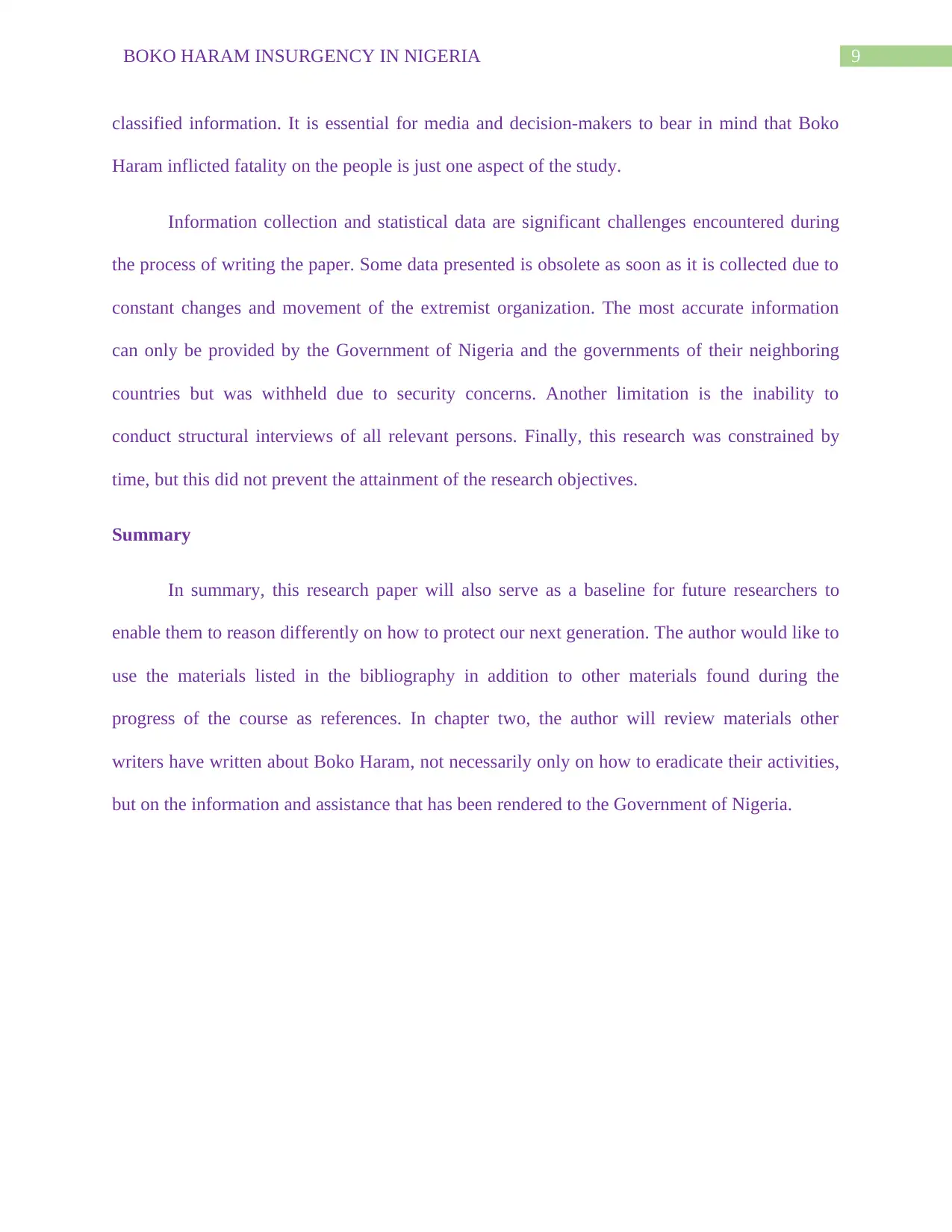
9BOKO HARAM INSURGENCY IN NIGERIA
classified information. It is essential for media and decision-makers to bear in mind that Boko
Haram inflicted fatality on the people is just one aspect of the study.
Information collection and statistical data are significant challenges encountered during
the process of writing the paper. Some data presented is obsolete as soon as it is collected due to
constant changes and movement of the extremist organization. The most accurate information
can only be provided by the Government of Nigeria and the governments of their neighboring
countries but was withheld due to security concerns. Another limitation is the inability to
conduct structural interviews of all relevant persons. Finally, this research was constrained by
time, but this did not prevent the attainment of the research objectives.
Summary
In summary, this research paper will also serve as a baseline for future researchers to
enable them to reason differently on how to protect our next generation. The author would like to
use the materials listed in the bibliography in addition to other materials found during the
progress of the course as references. In chapter two, the author will review materials other
writers have written about Boko Haram, not necessarily only on how to eradicate their activities,
but on the information and assistance that has been rendered to the Government of Nigeria.
classified information. It is essential for media and decision-makers to bear in mind that Boko
Haram inflicted fatality on the people is just one aspect of the study.
Information collection and statistical data are significant challenges encountered during
the process of writing the paper. Some data presented is obsolete as soon as it is collected due to
constant changes and movement of the extremist organization. The most accurate information
can only be provided by the Government of Nigeria and the governments of their neighboring
countries but was withheld due to security concerns. Another limitation is the inability to
conduct structural interviews of all relevant persons. Finally, this research was constrained by
time, but this did not prevent the attainment of the research objectives.
Summary
In summary, this research paper will also serve as a baseline for future researchers to
enable them to reason differently on how to protect our next generation. The author would like to
use the materials listed in the bibliography in addition to other materials found during the
progress of the course as references. In chapter two, the author will review materials other
writers have written about Boko Haram, not necessarily only on how to eradicate their activities,
but on the information and assistance that has been rendered to the Government of Nigeria.
Paraphrase This Document
Need a fresh take? Get an instant paraphrase of this document with our AI Paraphraser
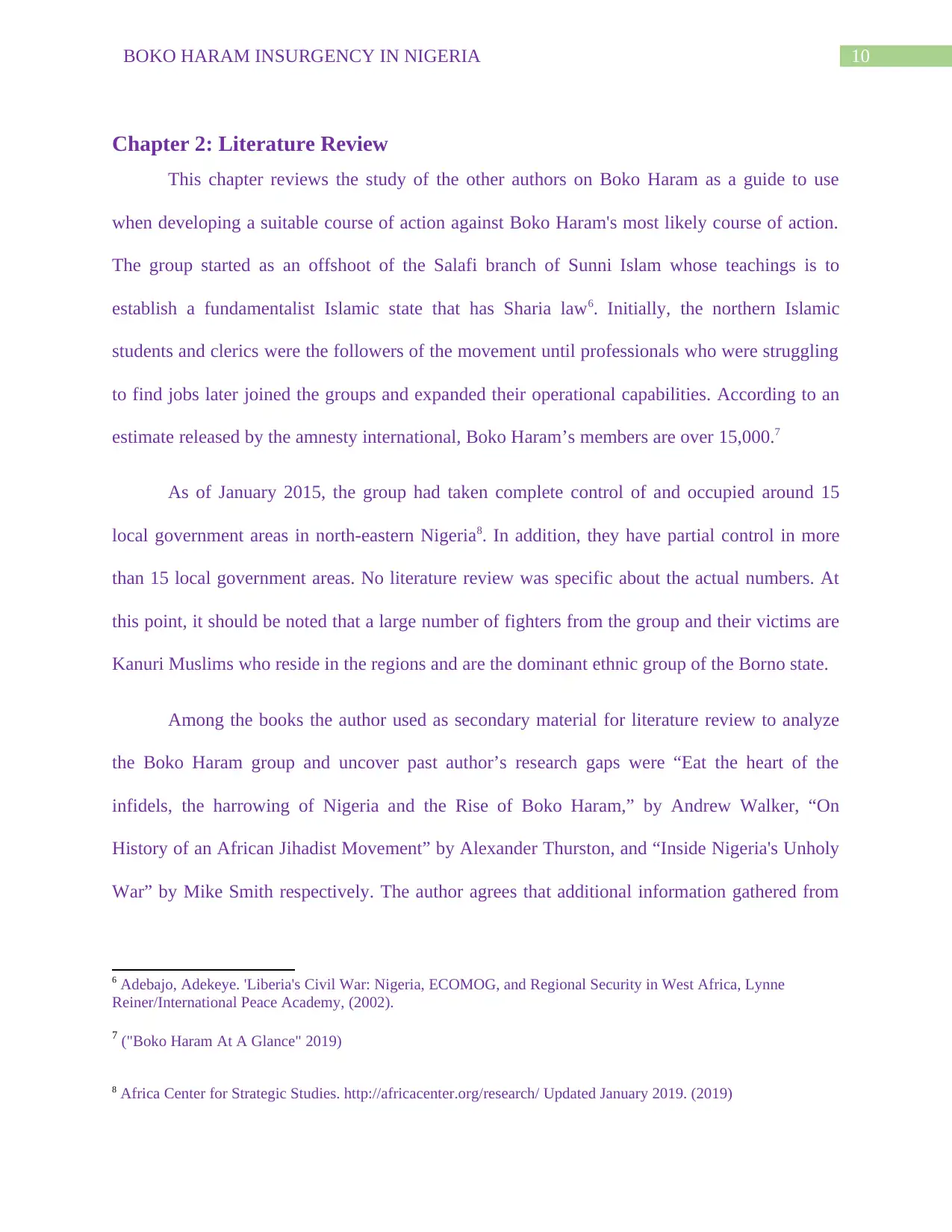
10BOKO HARAM INSURGENCY IN NIGERIA
Chapter 2: Literature Review
This chapter reviews the study of the other authors on Boko Haram as a guide to use
when developing a suitable course of action against Boko Haram's most likely course of action.
The group started as an offshoot of the Salafi branch of Sunni Islam whose teachings is to
establish a fundamentalist Islamic state that has Sharia law6. Initially, the northern Islamic
students and clerics were the followers of the movement until professionals who were struggling
to find jobs later joined the groups and expanded their operational capabilities. According to an
estimate released by the amnesty international, Boko Haram’s members are over 15,000.7
As of January 2015, the group had taken complete control of and occupied around 15
local government areas in north-eastern Nigeria8. In addition, they have partial control in more
than 15 local government areas. No literature review was specific about the actual numbers. At
this point, it should be noted that a large number of fighters from the group and their victims are
Kanuri Muslims who reside in the regions and are the dominant ethnic group of the Borno state.
Among the books the author used as secondary material for literature review to analyze
the Boko Haram group and uncover past author’s research gaps were “Eat the heart of the
infidels, the harrowing of Nigeria and the Rise of Boko Haram,” by Andrew Walker, “On
History of an African Jihadist Movement” by Alexander Thurston, and “Inside Nigeria's Unholy
War” by Mike Smith respectively. The author agrees that additional information gathered from
6 Adebajo, Adekeye. 'Liberia's Civil War: Nigeria, ECOMOG, and Regional Security in West Africa, Lynne
Reiner/International Peace Academy, (2002).
7 ("Boko Haram At A Glance" 2019)
8 Africa Center for Strategic Studies. http://africacenter.org/research/ Updated January 2019. (2019)
Chapter 2: Literature Review
This chapter reviews the study of the other authors on Boko Haram as a guide to use
when developing a suitable course of action against Boko Haram's most likely course of action.
The group started as an offshoot of the Salafi branch of Sunni Islam whose teachings is to
establish a fundamentalist Islamic state that has Sharia law6. Initially, the northern Islamic
students and clerics were the followers of the movement until professionals who were struggling
to find jobs later joined the groups and expanded their operational capabilities. According to an
estimate released by the amnesty international, Boko Haram’s members are over 15,000.7
As of January 2015, the group had taken complete control of and occupied around 15
local government areas in north-eastern Nigeria8. In addition, they have partial control in more
than 15 local government areas. No literature review was specific about the actual numbers. At
this point, it should be noted that a large number of fighters from the group and their victims are
Kanuri Muslims who reside in the regions and are the dominant ethnic group of the Borno state.
Among the books the author used as secondary material for literature review to analyze
the Boko Haram group and uncover past author’s research gaps were “Eat the heart of the
infidels, the harrowing of Nigeria and the Rise of Boko Haram,” by Andrew Walker, “On
History of an African Jihadist Movement” by Alexander Thurston, and “Inside Nigeria's Unholy
War” by Mike Smith respectively. The author agrees that additional information gathered from
6 Adebajo, Adekeye. 'Liberia's Civil War: Nigeria, ECOMOG, and Regional Security in West Africa, Lynne
Reiner/International Peace Academy, (2002).
7 ("Boko Haram At A Glance" 2019)
8 Africa Center for Strategic Studies. http://africacenter.org/research/ Updated January 2019. (2019)
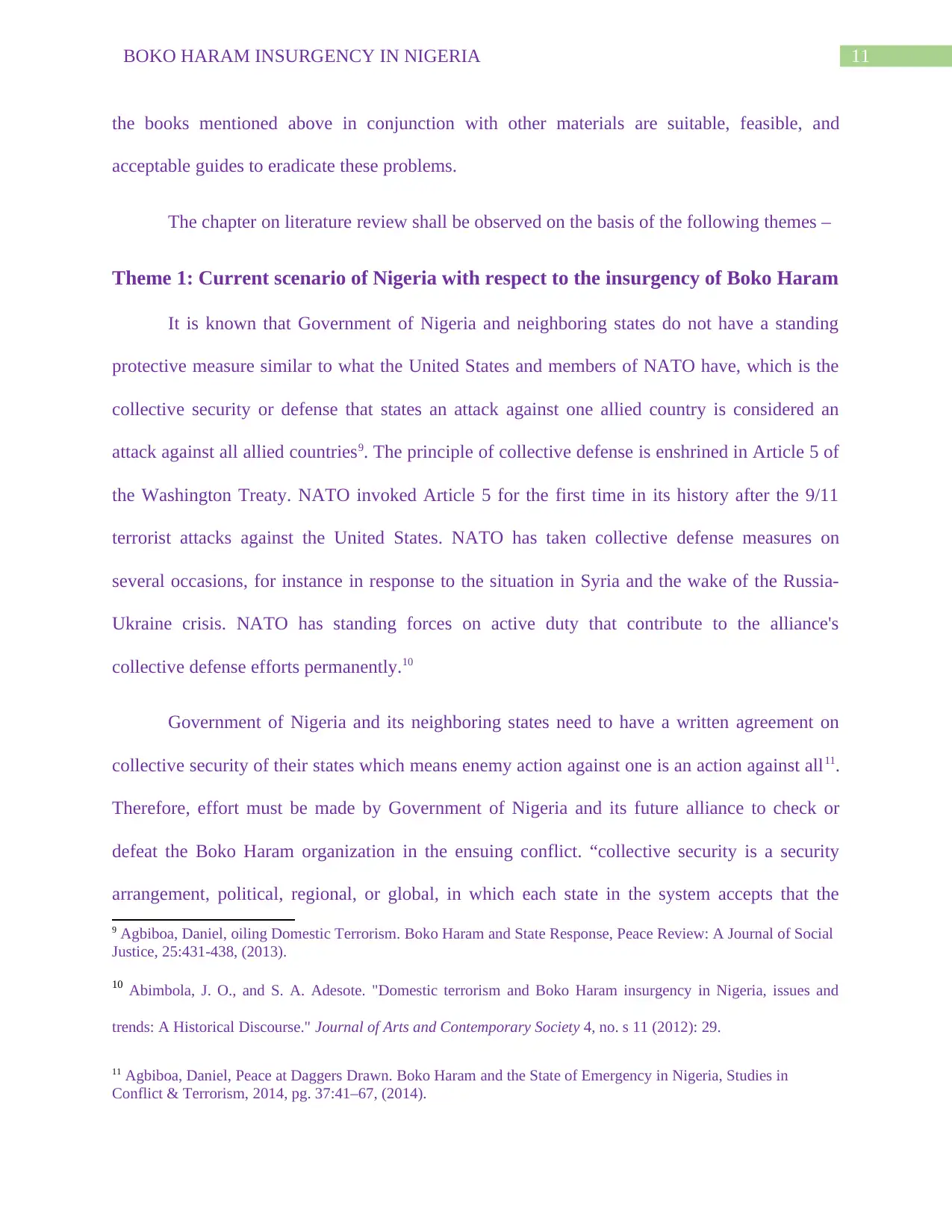
11BOKO HARAM INSURGENCY IN NIGERIA
the books mentioned above in conjunction with other materials are suitable, feasible, and
acceptable guides to eradicate these problems.
The chapter on literature review shall be observed on the basis of the following themes –
Theme 1: Current scenario of Nigeria with respect to the insurgency of Boko Haram
It is known that Government of Nigeria and neighboring states do not have a standing
protective measure similar to what the United States and members of NATO have, which is the
collective security or defense that states an attack against one allied country is considered an
attack against all allied countries9. The principle of collective defense is enshrined in Article 5 of
the Washington Treaty. NATO invoked Article 5 for the first time in its history after the 9/11
terrorist attacks against the United States. NATO has taken collective defense measures on
several occasions, for instance in response to the situation in Syria and the wake of the Russia-
Ukraine crisis. NATO has standing forces on active duty that contribute to the alliance's
collective defense efforts permanently.10
Government of Nigeria and its neighboring states need to have a written agreement on
collective security of their states which means enemy action against one is an action against all11.
Therefore, effort must be made by Government of Nigeria and its future alliance to check or
defeat the Boko Haram organization in the ensuing conflict. “collective security is a security
arrangement, political, regional, or global, in which each state in the system accepts that the
9 Agbiboa, Daniel, oiling Domestic Terrorism. Boko Haram and State Response, Peace Review: A Journal of Social
Justice, 25:431-438, (2013).
10 Abimbola, J. O., and S. A. Adesote. "Domestic terrorism and Boko Haram insurgency in Nigeria, issues and
trends: A Historical Discourse." Journal of Arts and Contemporary Society 4, no. s 11 (2012): 29.
11 Agbiboa, Daniel, Peace at Daggers Drawn. Boko Haram and the State of Emergency in Nigeria, Studies in
Conflict & Terrorism, 2014, pg. 37:41–67, (2014).
the books mentioned above in conjunction with other materials are suitable, feasible, and
acceptable guides to eradicate these problems.
The chapter on literature review shall be observed on the basis of the following themes –
Theme 1: Current scenario of Nigeria with respect to the insurgency of Boko Haram
It is known that Government of Nigeria and neighboring states do not have a standing
protective measure similar to what the United States and members of NATO have, which is the
collective security or defense that states an attack against one allied country is considered an
attack against all allied countries9. The principle of collective defense is enshrined in Article 5 of
the Washington Treaty. NATO invoked Article 5 for the first time in its history after the 9/11
terrorist attacks against the United States. NATO has taken collective defense measures on
several occasions, for instance in response to the situation in Syria and the wake of the Russia-
Ukraine crisis. NATO has standing forces on active duty that contribute to the alliance's
collective defense efforts permanently.10
Government of Nigeria and its neighboring states need to have a written agreement on
collective security of their states which means enemy action against one is an action against all11.
Therefore, effort must be made by Government of Nigeria and its future alliance to check or
defeat the Boko Haram organization in the ensuing conflict. “collective security is a security
arrangement, political, regional, or global, in which each state in the system accepts that the
9 Agbiboa, Daniel, oiling Domestic Terrorism. Boko Haram and State Response, Peace Review: A Journal of Social
Justice, 25:431-438, (2013).
10 Abimbola, J. O., and S. A. Adesote. "Domestic terrorism and Boko Haram insurgency in Nigeria, issues and
trends: A Historical Discourse." Journal of Arts and Contemporary Society 4, no. s 11 (2012): 29.
11 Agbiboa, Daniel, Peace at Daggers Drawn. Boko Haram and the State of Emergency in Nigeria, Studies in
Conflict & Terrorism, 2014, pg. 37:41–67, (2014).
⊘ This is a preview!⊘
Do you want full access?
Subscribe today to unlock all pages.

Trusted by 1+ million students worldwide
1 out of 53
Related Documents
Your All-in-One AI-Powered Toolkit for Academic Success.
+13062052269
info@desklib.com
Available 24*7 on WhatsApp / Email
![[object Object]](/_next/static/media/star-bottom.7253800d.svg)
Unlock your academic potential
Copyright © 2020–2025 A2Z Services. All Rights Reserved. Developed and managed by ZUCOL.



